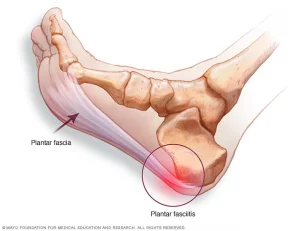Plantar Fasciitis
Plantar Fasciitis, commonly known as heel pain:
- Is one of the most common causes of heel pain.
- Has been estimated to affect about two million people in the US,
- Affects both sedentary and athletic people, is thought to result from chronic overload either from lifestyle or exercise.
- Results from repetitive stress to the plantar fascia at its origin on the medial tubercle of the calcaneus
- Is often associated with gastrocnemius/calf tightness.
- Most common symptom is aching heel pain, worst with first step in the morning or after periods of rest.
- Diagnosis is confirmed with point tenderness at the origin of the plantar fascia on the medial tubercle of the calcaneus (inner aspect of heel)
- Reduced ankle dorsiflexion (ability to contract the muscles of shin and increase the forward bend at the ankle and bring toes towards your nose) appears to be the most significant risk factor and calf muscle tightness as the most common cause of limited dorsiflexion ROM.
- A tight gastroc-soleus complex can cause increased pronation or inward collapse of foot, in midstance( when foot is weight bearing) as well as early heel-off in gait, which leads to increased knee extension and increased stress through the forefoot and plantar fascia, and prolonged stress could increase stress on your planter fascia.
- A tight gastroc-soleus can be both a cause and an effect of plantar fasciitis. Studies show that patients with chronic plantar fasciopathy often walk with a slower cadence, shorter stride length. These antalgic gait changes can lead to further muscle imbalance, resulting in loss of strength and flexibility, thus highlighting the importance of continuing with flexibility exercises in conjunction with other treatment modalities.
Body mass index (BMI) is strongly associated with plantar fasciitis; those with a BMI of 30 or more (1.48 percent) were 5 times more likely to have plantar fasciitis than those with a BMI less than 25 (0.29 percent).

